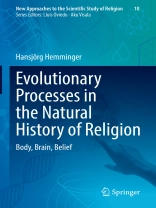The study of religion by the humanities and social sciences has become receptive for an evolutionary perspective. Some proposals model the evolution of religion in Darwinian terms, or construct a synergy between biological and non-Darwinian processes. The results, however, have not yet become truly interdisciplinary. The biological theory of evolution in form of the Extended Evolutionary Synthesis (EES) is only sparsely represented in theories published so far by scholars of religion. Therefore this book reverses the line of view and asks how their results assort with evolutionary biology:
- How can the subject area “religion” integrated into behavioral biology?
- How is theory building affected by the asymmetry between the scarce empirical knowledge of prehistoric religion, and the body of knowledge about extant and historic religions?
- How does hominin evolution in general relate to the evolution of religion? Are there evolutionary pre-adaptations?
- Subsequent versions of evolutionary biology from the original Darwinism to EES are used in interdisciplinary constructs. Can they be integrated into a comprehensive theory?
- The biological concept most often used is co-evolution, in form of a gene-culture co-evolution. However, the term denotes a process different from biological co-evolution.
- Important EES concepts do not appear in present models of religious evolution: e.g. neutral evolution, evolutionary drift, evolutionary constraints etc. How to include them into an interdisciplinary approach?
- Does the cognitive science of religion (CSR) harmonize with behavioral biology and the brain sciences?
- Religion as part of human culture is supported by a complex, multi-level behavioral system. How can it be modeled scientifically?
The book addresses graduate students and researchers concerned about the scientific study of religion, and biologist interested in interdisciplinarytheory building in the field.
Tabella dei contenuti
Introduction.- I. Religion through the eyes of a biologist.- 1. Evolution in all its facets.- 2. The scientific approach to religion.- 3. What do we know? What can be known?.- 4. Understanding religion from the inside.- II. About evolutionary biology and the evolution of religion.- 5. Evolution: The Modern Synthesis.- 6. Extended Evolutionary Synthesis, epigenetics and the contingency of evolution.- 7. Gene-culture coevolution.- III. Phenomenology of Paleolithic religion.- 8. A story told backwards.- 9. The beginning and the end: Pre-human and Neolithic religion.- 10. Hominin pre-adaptations: Background to the evolution of religion.- IV. CSR: The cognitive science of religion.- 11. Evolutionary psychology and religion.- 12. Religious fanaticism.- 13. Practical religion and spirituality.- 14. Magic, religion and evolutionary ethics.- V. Modeling the evolutionary path to culture and religion.- 15. Multi-level models of religious evolution.- 16. Conclusion and outlook.
Circa l’autore
Hansjörg Hemminger received his postdoctoral qualification as a university teacher of behavioral biology (Habilitation) from the University of Freiburg (Germany). He was commissioner for world view questions, especially for the dialogue between science and religion, in the Protestant Church until retirement. As an expert member of a parliament commission (Bundestag) he investigated fanatic and sectarian forms of religion. He published numerous articles and books in German and English.











